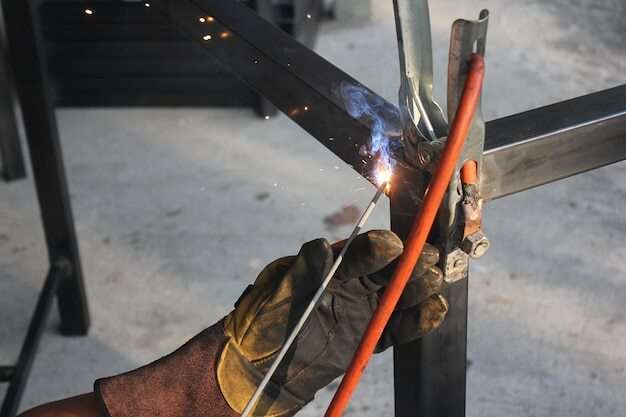Welding is a crucial skill in many industries. Having the right equipment is essential for both safety and efficiency. One of the most important pieces of equipment for any welder is the ground clamp. A proper and safe welding ground clamp ensures a stable and secure connection. This is vital for a clean and effective weld. We’ll share tips for getting a proper and safe welding ground clamp. We will compare different types, like magnetic welding ground clamps, and provide new insights. Let’s get started!
Why is a Welding Ground Clamp Important?
Before we dive into the tips, it’s important to understand what a welding ground clamp does. The ground clamp completes the electrical circuit during welding. A good ground clamp provides a stable connection between the workpiece and the welder. This ensures that the welding process is both efficient and safe. Poor ground connections can lead to weak welds, more spatter, and even electrical hazards.
Choosing the Right Welding Ground Clamp
1. Understand the Different Types
There are several types of welding ground clamps. Each has its pros and cons. The most common types include:
- C-Clamp: This is the traditional type of welding ground clamp. It provides a strong grip and is suitable for heavy-duty welding. However, it can be hard to attach and remove.
- Magnetic Welding Ground Clamp: These clamps use strong magnets to attach to the workpiece. They are quick and easy to use. This makes them ideal for frequent welding tasks. However, they may not provide as strong a connection as mechanical clamps.
- Spring-Loaded Clamp: This type uses a spring to provide a secure grip. It is easy to use and offers a good balance between convenience and strength.
2. Consider the Amperage Rating
The amperage rating of the ground clamp is crucial. Make sure the clamp you choose can handle the maximum amperage of your welder. Using a clamp with a lower amperage rating can lead to overheating and possible failure.
3. Check the Material and Build Quality
The material and build quality of the ground clamp are important for durability and performance. Look for clamps made from high-quality materials like copper or brass. These materials offer excellent conductivity and resist corrosion.
4. Ensure a Secure Connection
A secure connection is vital for effective welding. Make sure the clamp can grip the workpiece firmly without slipping. Magnetic clamps should have strong magnets. Mechanical clamps should have strong gripping mechanisms.
Tips for Using a Welding Ground Clamp Safely
1. Inspect the Clamp Regularly
Regular inspection of the ground clamp is essential for safety. Check for any signs of wear or damage, like frayed cables or corroded connections. Replace any damaged parts immediately to keep a safe welding environment.
2. Clean the Contact Surfaces
Dirty or corroded contact surfaces can hurt the performance of the ground clamp. Clean the surfaces regularly with a wire brush or sandpaper. This ensures a good electrical connection.
3. Position the Clamp Correctly
The position of the ground clamp can affect the quality of the weld. Place the clamp as close to the welding area as possible. This minimizes resistance and ensures a stable connection.
4. Use Proper Personal Protective Equipment (PPE)
Always wear appropriate PPE when welding. This includes gloves, safety glasses, and welding helmets. PPE not only protects you from sparks and UV radiation but also reduces the risk of electrical shock from the ground clamp.
Advanced Tips for Optimizing Your Welding Ground Clamp
1. Use Multiple Clamps for Large Workpieces
For large workpieces, using multiple ground clamps can help ensure a stable connection across the entire surface. This is especially useful for large-scale projects where one clamp may not provide enough coverage.
2. Invest in High-Quality Clamps
While it might be tempting to save money by buying cheaper ground clamps, investing in high-quality clamps can pay off in the long run. High-quality clamps are more durable, provide better conductivity, and reduce the risk of electrical hazards.
3. Consider Using Grounding Cables
The ground clamp, using grounding cables can help improve the stability of the electrical connection. These cables can be attached to different points on the workpiece, providing extra grounding support.
4. Monitor the Temperature
Overheating can be a sign of a poor ground connection. If you notice the clamp or cables becoming very hot, stop welding immediately and inspect the setup. Make sure that the connections are secure and that the clamp is suitable for the amperage being used.
Comparing Different Types of Welding Ground Clamps
C-Clamp vs. Magnetic Welding Ground Clamp
C-clamps are known for their strong grip and durability. They are ideal for heavy-duty welding tasks and provide a secure connection even on rough surfaces. However, they can be hard to use and may require more effort to attach and remove.
Magnetic welding ground clamps, on the other hand, are very convenient and easy to use. They are perfect for quick and frequent welding tasks, especially on flat and smooth surfaces. The downside is that their grip may not be as strong as mechanical clamps, especially on dirty or uneven surfaces.
Spring-Loaded Clamp vs. Traditional Clamp
Spring-loaded clamps offer a good balance between convenience and strength. They are easy to use and provide a secure grip without the need for manual tightening. Traditional clamps, like the C-clamp, offer superior strength but can be more challenging to handle.
New Insights and Innovations in Welding Ground Clamps
1. Hybrid Clamps
Recent innovations have led to the development of hybrid welding ground clamps that combine the strengths of different types. For example, some clamps feature a combination of magnetic and mechanical gripping mechanisms, providing both convenience and a strong connection.
2. Smart Clamps
Smart clamps are equipped with sensors and indicators that provide real-time feedback on the connection quality. These clamps can alert the user to issues like poor contact or overheating, enhancing safety and performance.
3. Ergonomic Designs
Modern ground clamps are being designed with ergonomics in mind, making them easier and more comfortable to use. Features like padded handles and quick-release mechanisms help reduce user fatigue and improve efficiency.
Conclusion
Choosing the right welding ground clamp is essential for both safety and performance. By understanding the different types of clamps available, considering factors like amperage rating and build quality, and following safety tips, you can ensure a stable and secure connection for your welding projects. Keep an eye out for innovations and advancements in welding ground clamps, and don’t hesitate to invest in high-quality equipment for the best results.







